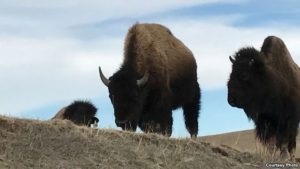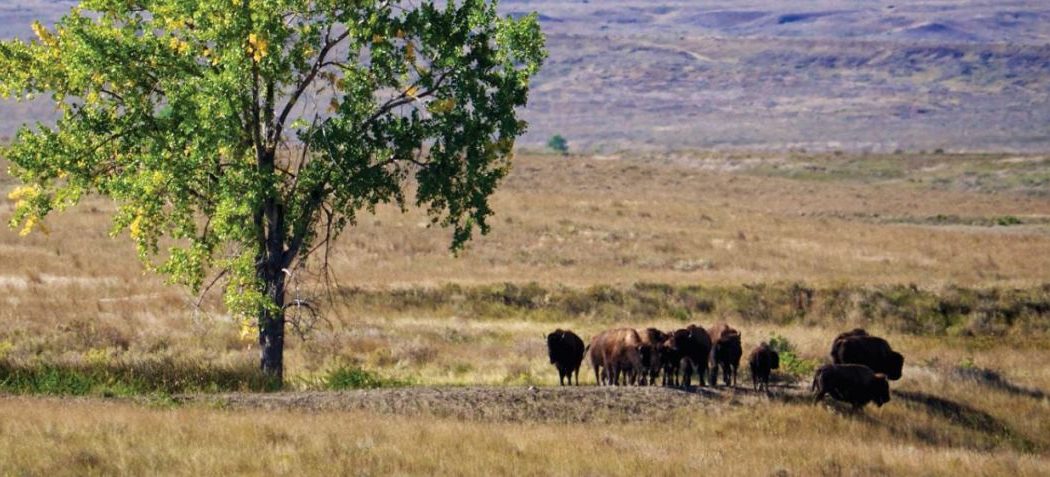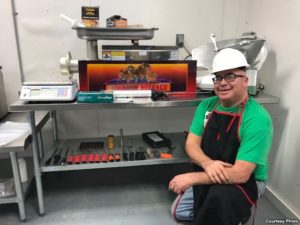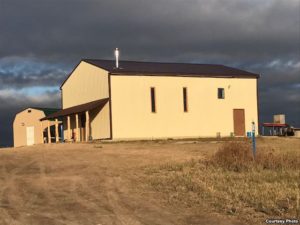The Lakota (also known as Teton Sioux) speak speak the Lakota language and traditionally occupied lands in both North and South Dakota. The seven bands or “sub-tribes” of the Lakota are:
- Sičháŋǧu (Brulé, Burned Thighs);
- Itázipčho (Sans Arc, Without Bows);
- Húŋkpapȟa (Hunkpapa, “End Village”;
- Mnikȟówožu (Miniconjou, “Plant Near Water”;
- Sihásapa (“Black Feet”);
- Oóhenuŋpa (Two Kettles); and
- Oglála (“They Scatter Their Own”).
The Oglala Lakota on the Pine Ridge Reservation in South Dakota are now one step closer to restoring their traditional diet: The Charging Buffalo Meat House is about to open for business, processing and packaging bison meat from the tribe’s own herd.
Buffalo were for centuries the lifeline of Plains tribes, a source of food, clothing, shelter and even weapons and utensils. In the 19th century, the U.S. Army recognized the best way to force Indians onto reservations was to destroy their greatest resource. Aided by sportsmen and trophy hunters, the Army slaughtered buffalo to near-extinction in what was probably the most ecologically-destructive ethnic cleansing atrocity in human history.
Tribes were forced to abandon their traditional diet and survive off government rations of flour, oil and coffee; these were gradually replaced by processed, packaged foods. There’s only one supermarket on the reservation, but with unemployment running at about 80 percent on Pine Ridge, many must rely on cheap, filling food that is low in nutrition and high in fat.
Today, obesity, diabetes and heart disease are rampant on Pine Ridge, and life expectancy is the lowest in the nation.
Charles “Bamm” Brewer believes the solution for Lakota lies in returning to a traditional diet of wild fruits and vegetables—and, of course, buffalo.
He began small, taking out a loan to fence in his family’s land allotment, about 325 hectares (800 acres), and slowly, he began building up a herd of stock culled from federally-owned herds in nearby national parks.
“Every other year, the national park has surplus, and to be eligible to buy, tribes have to have pastures big enough to hold the buffalo. So, the tribe created a sharecrop program, where tribal members can turn their land into buffalo pastures and get 60 percent of the calf crop,” he explained.
Today his herd amounts to about 50, and buffalo has been part of his family’s diet for years. The Lakota, like other tribes, never killed buffalo for sport.
About seven years ago, Brewer took a job as food program manager for One Spirit, a local non-profit group that distributes fresh food and produce to families in need. It occurred to him that if One Spirit could build a meat-processing plant, it could include buffalo meat in those distributions.
One Spirit launched a fundraising campaign, and donors heeded the call. As of February 2018, the Charging Buffalo Meat House was only about $15,000 away from becoming fully operational; it lacks only a heating and air conditioning system to begin operating as a “custom exempt” meat processing facility, that is, gaining state approval to process and package buffalo meat for individual owners and hunters.
One Spirit hopes to someday gain federal Food and Drug Administration approval and enter the open market. These days, there’s a big demand for buffalo meat, a $340-million industry, according to the National Bison Association.
ONE Spirit is a Native American service organization founded to assist and support American Indians. We are proud to think of our organization, ONE Spirit, as a group of people who exchange friendship with American Indians. At present, our focus are the Oglala Lakota in South Dakota. We invite you to become part of ONE Spirit’s network of sponsors, partners, friends and volunteers, to dream with the Lakota people a new dream – and to help the dreams come alive!
Their mission is to help the Lakota meet their basic needs and provide a culturally rich life for their youth. One Spirit’s programs promote an intercultural relationship that recognizes that we are all related and that American Indians are an equal and valued part of our society.
 The goal of all their programs is to reduce or eliminate hunger, to replace the high drop out and suicide rates among youth with an enthusiasm for learning and a pride in their Lakota heritage, and to provide protection from the winter cold that can drop to 40 below zero.
The goal of all their programs is to reduce or eliminate hunger, to replace the high drop out and suicide rates among youth with an enthusiasm for learning and a pride in their Lakota heritage, and to provide protection from the winter cold that can drop to 40 below zero.
This inspring story on the Pine Ridge reservation is just one aspect of a far larger trend towards restoring bison to the great plains (and possibly to the Eastern forests someday), in part to restore the health of the ecosystems that once relied on them.
One of many organizations working towards this goal is American Prairie Reserve. here’s what they say on their website:
“Bison used to number in the millions on the Great Plains, but animals in conservation herds now number less than 20,000 and are considered ‘near threatened.’ Because most herds are less than 500 on small landscapes, scientists have agreed that bison have become ecologically extinct. This means they no longer play the critical roles in shaping prairie biodiversity.
The plains bison, also commonly known as the buffalo, is an iconic symbol of the free and open spirit of the North American prairie. While tens of millions of bison, described as “innumerable” by early 18th century European explorers, once roamed the Great Plains, only an estimated 500,000 bison remain in North America today. Of these, less than 4% (about 19,000 bison) live in conservation herds. Most of the bison on the landscape today are raised for commercial purposes.
We restore bison to their original habitat on American Prairie Reserve lands, providing modern visitors a chance to witness the majestic species that astounded the earliest explorers and played a central role in the culture and spirituality of Native Americans. Thanks to donors and collaborators, the Reserve reintroduced bison on our lands in 2005, returning a species that had been gone from the landscape for more than 120 years. Since then, the herd has grown to nearly 900 animals through additional imports and births.”
All photos courtesy of One Spirit, except the featured photo, which is courtesy of American Prairie Reserve.
See article by Cecily Hilleary on the Voice of America website.
Learn more about the project on the One Spirit website.
Watch videos and donate here to the Charging Buffalo project.



